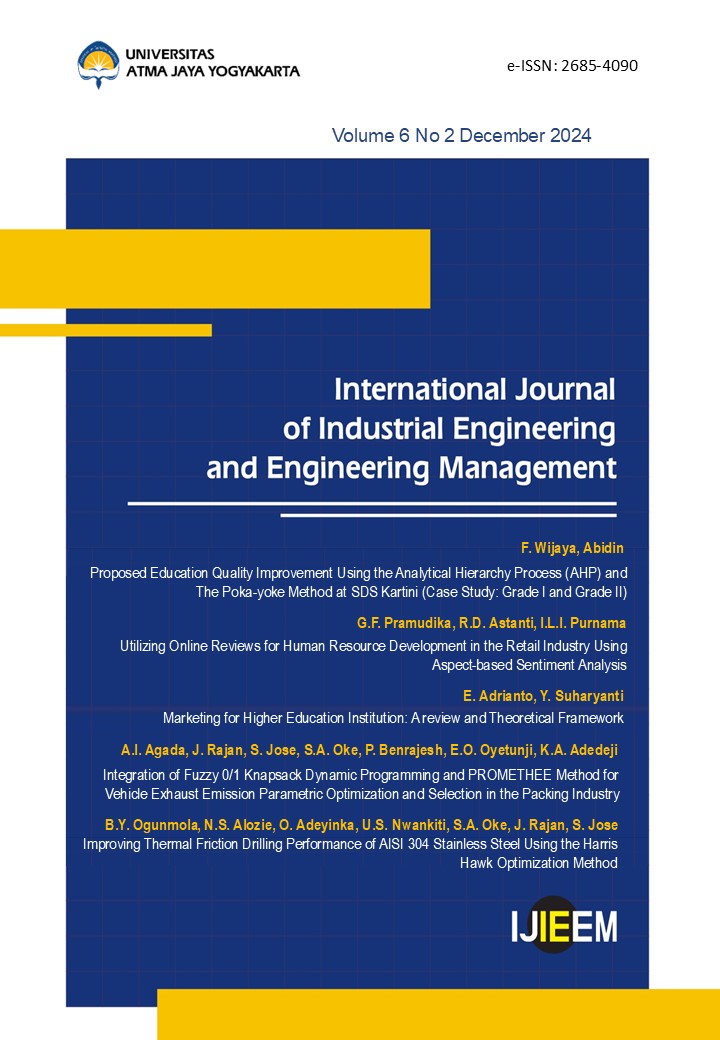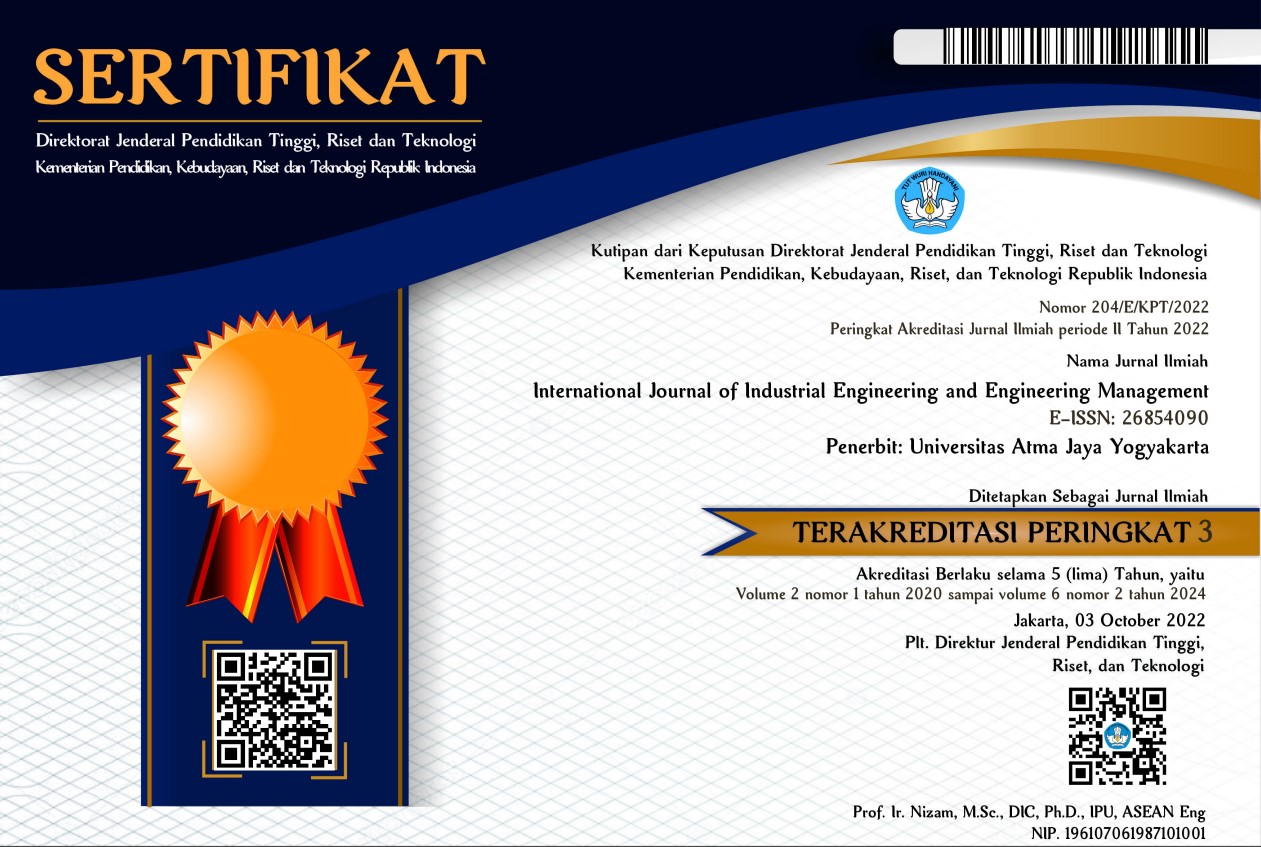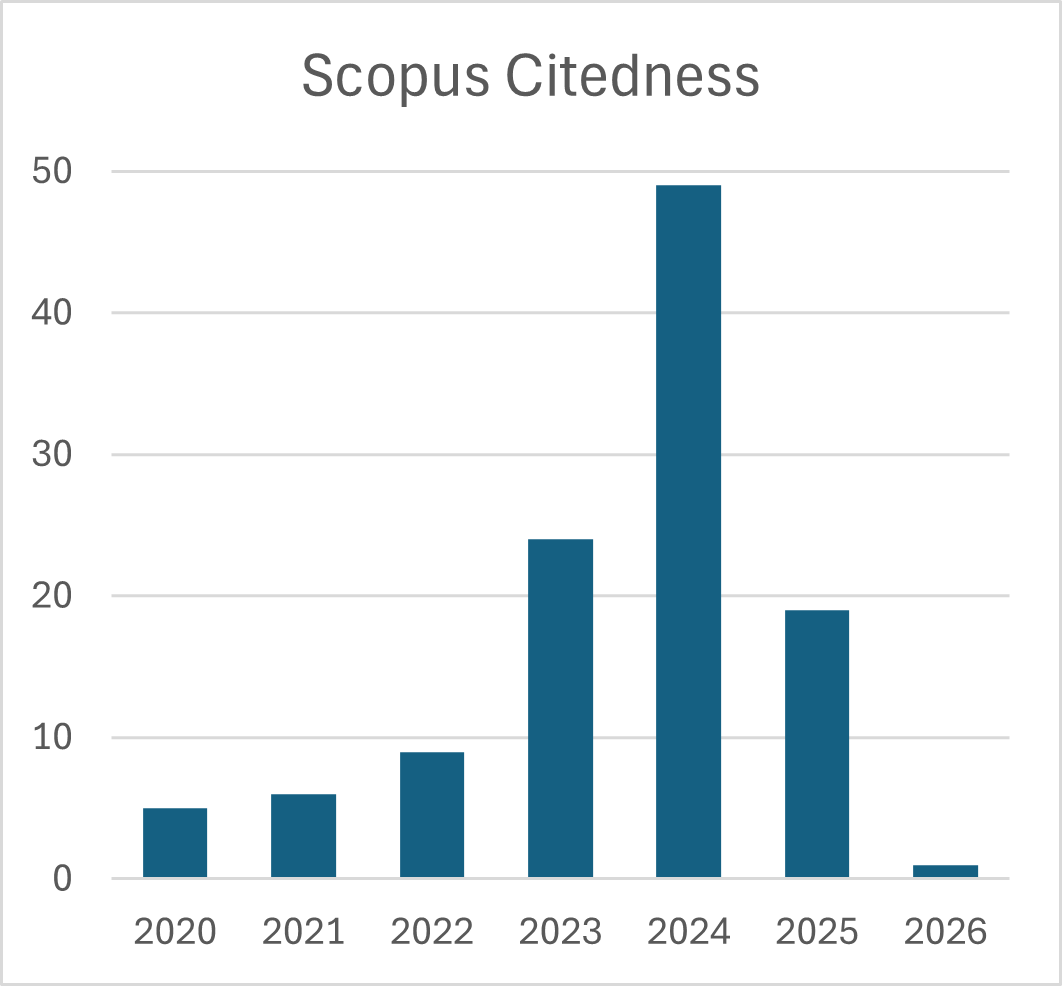Marketing for Higher Education Institution: A Review and Theoretical Framework
DOI:
https://doi.org/10.24002/ijieem.v6i2.9639Keywords:
higher education, marketing, modified marketing mix, marketing factors, theoretical frameworkAbstract
A higher education institution (HEI) builds its quality throughout the process, from student admission to graduation. One of the critical points in the admission process, by which the applicants are selected, is the number of applicants being selected. To get a large number of applicants, an HEI undertakes marketing programs. Many studies on HEI marketing discuss factors differently, depending on the case and the viewpoints or the objectives. This study reviews 52 articles on HEI marketing to get general insights and develop a theoretical framework that is expected to be beneficial for HEI practitioners to design their marketing programs and for researchers to get a general model to be referred to. The insights from the review are, first, the development of modified marketing mix 3P1Q (quality, price, promotion, place) for HEI marketing, which is adapted from marketing mix 4P. The second insight is that the focus of HEI marketing discussion has shifted because of the COVID-19 pandemic, regarding the disruption and the intense use of digital technology. This phenomenon could help interested parties predict the future of HEI marketing. The result of this study is a comprehensive theoretical framework of HEI marketing that integrates HEI attributes, HEI marketing factors, HEI marketing impacts, and the relationships among those elements.
References
Amelia, R., & Ayani, S. (2020). Optimalisasi membangun brand image terhadap customer loyalty melalui customer value dan customer retention sebagai variabel intervening. Ekonomi Bisnis, 26(1), 268-279.
Alwi, S., Che-Ha, N., Nguyen, B., Ghazali, E.M., Mutum, D.M., & Kitchen, P.J. (2020). Projecting university brand image via satisfaction and behavioral response perspectives from UK-based Malaysian students. Qualitative Market Research: An International Journal, 23(1), 47-68.
Anizir & Wahyuni, R. (2017). Pengaruh social media marketing terhadap brand image perguruan tinggi swasta di Kota Serang. Sains Manajemen: Jurnal Manajemen Unsera, 3(2), 1-14.
Anwar, C., & Budiman, F. (2016). Pengaruh brand image dan lapangan pekerjaan terhadap keputusan mahasiswa untuk memilih jurusan akuntansi pada perguruan tinggi yang ada di Bandar Lampung. Akuntansi and Keuangan, 7(2), 255-276.
Ariwibowo, M.E. (2019). Strategi pemasaran lembaga pendidikan tinggi swasta. Scientific Journal of Reflection: Economic, Accounting, Management and Business, 2(2), 181-190.
Basha, N.K., Sweeney, J.C., & Soutar, G.N. (2019). Evaluating students’ preferences for university brands through conjoint analysis and market simulation. International Journal of Educational Management, 34(2), 263-278.
Binus University Online. (2021). Begini Perbedaan Generasi Baby boomers, X, Y, Z, dan Alpha. Binus Higher Education: https://onlinelearning.binus.ac.id/2021/12/06/begini-perbedaan-generasi-baby-boomers-x-y-z-dan-alpha/
Bonilla, M.R., Perea, E., del Olmo, J.L., & Corrons, A. (2019). Insights into user engagement on social media: A case study of a higher education institution. Journal of Marketing for Higher Education, 30(1), 145-160.
Brewer, A., & Zhao, J. (2010). The impact of a pathway college on reputation and brand awareness for its affiliated university in Sydney. International Journal of Educational Management, 24(1), 34-47.
Dewi, L., & Magdalena, F. (2017). Pengaruh personal selling dan word of mouth terhadap brand awareness bisnis mahasiswa Universitas Ciputra. Eksekutif, 14(2), 5-20.
Durkin, M., McKenna, S., & Cummins, D. (2012). Emotional connection in higher education marketing. International Journal of Educational Management, 26(2), 153-161.
Dwiyama, F., & Nurhasanah (2020). The role of stakeholders in building a brand image at Madrasah Aliyah. Nidhomul Haq: Jurnal Manajemen Pendidikan Islam, 5(3), 375-391.
Eldegwy, A., Elsharnouby, T.H., & Kortam, W. (2018). How sociable is your university brand? An empirical investigation of university social augmenters’ brand equity. International Journal of Educational Management, 32(5), 912-930.
Foroudi, P., Dinnie, K., Kitchen, P.J., Melewar, T.C., & Foroudi, M.M. (2016). IMC antecedents and the consequences of planned brand identity in higher education. European Journal of Marketing, 51(3), 528-550.
Frølich, N., & Stensaker, B. (2010). Student recruitment strategies in higher education: Promoting excellence and diversity? International Journal of Educational Management, 24(4), 369-370.
Girard, T., & Pinar, M. (2020). An empirical study of the dynamic relationships between the core and supporting brand equity dimensions in higher education. Journal of Applied Research in Higher Education, 13(3), 710-740.
Hamed, A., Jamil, S., & Rafiq, H.A. (2022). University branding and student satisfaction: The emerging landscape of universities in Pakistan. Pakistan Journal of Educational Research, 5(2), 429-449.
Handra, T. (2021). Service quality terhadap word of mouth dan dampaknya terhadap pembentukan brand image perguruan tinggi di Tangerang Raya. Jurnal Cafetaria, 2(2), 43-53.
Hanson, T.A., Bryant, M.R., & Lyman, K.J. (2019). Intercollegiate athletic programs, university brand equity, and student satisfaction. International Journal of Sports Marketing and Sponsorship, 21(1), 106-126.
Harahap, D.S., Amanah, D., Gunarto, M., Purwanto, & Umam, K. (2020). Pentingnya citra universitas dalam memilih studi di perguruan tinggi. Niagawan, 9(3), 191-196.
Hemsley-Brown, J., Melewar, T.C., Nguyen, B., & Wilson, E.J. (2016). Exploring brand identity, meaning, image, and reputation (BIMIR) in higher education: A special section. Journal of Business Research, 69(8), 3019-3022.
Herrero-Crespo, Á., Gutiérrez, H.S.M., & Garcia-Salmones, M.M. (2016). Influence of country image on country brand equity: Application to higher education services. International Marketing Review, 33(5), 691-714.
Kango, U., Kartiko, A., & Ma`arif, M.A. (2021). The effect of promotion on the decision to choose a higher education through the brand image of education. Al-Ishlah: Jurnal Pendidikan, 13(3), 1611-1621.
Kaushal, V., Jaiswal, D., Kant, R., & Ali, N. (2021). Determinants of university reputation: Conceptual model and empirical investigation in an emerging higher education market. International Journal of Emerging Market, 12(8), 1846-1867.
Kotler, P., Armstrong, G., & Balasubramanian, S. (2024). Principles of Marketing (19th ed.). Harlow: Pearson Education Ltd.
Kumar, V., & Nanda, P. (2019). Social media in higher education: A framework for continuous engagement. International Journal of Information and Communication Technology Education, 15(1), 97-108.
Kusumah, E.P., & Yusuf, S. (2020). Perspektif mahasiswa terhadap kualitas “branding” perguruan tinggi. Jurnal Akuntabilitas Manajemen Pendidikan, 8(1), 24-33.
Lim, W.M., Jee, T.W., & De Run, E.C. (2018). Strategic brand management for higher education institutions with graduate degree programs: Empirical insights from the higher education marketing mix. Journal of Strategic Marketing, 28(3), 225-245.
Matongolo, A., Kasekende, F., & Mafabi, S. (2018). Employer branding and talent retention: Perceptions of employees in higher education institutions in Uganda. Industrial and Commercial Training, 50(5), 217-233.
Miotto, G., Del-Castillo-Feito, C., & Blanco-González, A. (2020). Reputation and legitimacy: Key factors for higher education institutions’ sustained competitive advantage. Journal of Business Research, 112, 342-353.
Mourad, M., Meshreki, H., & Sarofim, S. (2019). Brand equity in higher education: comparative analysis. Studies in Higher Education, 45(1), 209-231.
Mulyono, H. (2016). Brand awareness and brand image of decision-making on university. Jurnal Manajemen dan Kewirausahaan, 18(2), 163-173.
Murti, T.K. (2019). Pengaruh brand image, promosi dan biaya pendidikan terhadap keputusan mahasiswa melanjutkan studi pada Program Studi Pendidikan Ekonomi. Jurnal Ilmiah Pendidikan Ekonomi Fakultas Keguruan dan Ilmu Pendidikan, 7(2), 102-107.
Nulhaqim, S.A., Heryadi, R.D., Pancasilawan, R., & Fedryansyah, M. (2016). Peranan Perguruan Tinggi dalam Meningkatkan Kualitas Pendidikan di Indonesia untuk Menghadapi ASEAN Community 2015. Share Social Work Journal, 6(2), 154-272.
Perera, C.H., Nayak, R., & Nguyen, L.T.V. (2020). The impact of subjective norms, eWOM and perceived brand credibility on brand equity: Application to the higher education sector. International Journal of Educational Management, 35(1), 63-74.
Peters, G., & Woolley, J.T. (2024). Special Message to the Congress on Education. The American Presidency Project: https://www.presidency.ucsb.edu/documents/special-message-the-congress-education-1
Pham, H., & Starkey, L. (2016). Perceptions of higher education quality at three universities in Vietnam. Quality Assurance in Education, 24(3), 369-393.
Pinar, M., Girard, T., & Basfirinci, C. (2020). Examining the relationship between brand equity dimensions and university brand equity: An empirical study in Turkey. International Journal of Educational Management, 34(7), 1119-1141.
Pringle, J., & Fritz, S. (2018). The university brand and social media: Using data analytics to assess brand authenticity. Journal of Marketing for Higher Education, 29(1), 19-44.
Pucciarelli, F., & Kaplan, A. (2016). Competition and strategy in higher education: Managing complexity and uncertainty. Business Horizon, 59(3), 311-320.
Rauschnabel, P.A., Krey, N., Babin, B.J., & Ivens, B.S. (2016). Brand management in higher education: The university brand personality scale. Journal of Business Research, 69(8), 3077-3086.
Sataøen, H.L. (2019). Sub-sector branding and nation branding: The case of higher education. Corporate Communications: An International Journal, 24(3), 425-438.
Schlesinger, W., Cervera-Taulet, A., & Wymer, W. (2021). The influence of university brand image, satisfaction, and university identification on alumni WOM intentions. Journal of Marketing for Higher Education, 33(1), 1-19.
Shehzadi, S., Nisar, Q.A., Hussain, M.S., Basheer, M.F., Hameed, W.U., & Chaudhry, N.I. (2020). The role of digital learning toward students’ satisfaction and university brand image at educational institutes of Pakistan: A post-effect of COVID-19. Asian Education and Development Studies, 10(2), 276-294.
Shields, A.B., & Peruta, A. (2018). Social media and the university decision: Do prospective students really care? Journal of Marketing for Higher Education, 29(1), 67-83.
Simoes, C., & Soares, A.M. (2014). Applying to higher education: Information sources and choice factors. Studies in Higher Education, 35(4), 371-389.
Tien, N.H., Minh, H.T.T., & Dan, P.V. (2019). Branding building for Vietnam higher education industry reality and solutions. International Journal of Research in Marketing Management and Sales, 1(2), 118-123.
Vrontis, D., Nemar, S.E., Ouwaida, A., & Shams, S.M.R. (2018). The impact of social media on international student recruitment: The case of Lebanon. Journal of International Education in Business, 11(1), 79-103.
Wijaya, N.P.N.P., Hurriyati, R., & Dirgantari, P.D. (2023). Pengaruh word of mouth dan world class university terhadap pemilihan perguruan tinggi. Coopetition: Jurnal Ilmiah Manajemen, 14(1), 43-54.
Yasa, N.N.K., Giantari, I.G.A.K., Rahmayanti, P.L.D., & Tirtayani, I.G.A. (2021). Antecedent of WOM and its implications on the brand image of the higher education institution in Bali. Jurnal Dinamika Manajemen, 12(2), 245-261.
Downloads
Published
How to Cite
Issue
Section
License
Copyright (c) 2024 Ega Adrianto, Yosephine Suharyanti

This work is licensed under a Creative Commons Attribution 4.0 International License.








